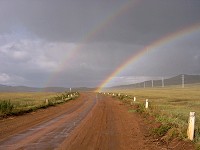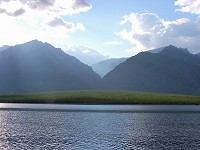| Origin & Development | |
|
Legends & Fairy tales • Earth's Crust Thickness • Underwater Relief • Landscapes • History & Formation • Seismic Activity • | |
| History of Lake Baikal | |
|
History of Explorations • Inhabitants & Settlers • First maps of Baikal • Archaeological Sites • | |
| Lake Baikal Climate | |
|
Introduction • Fogs • Winds & Waves • Ice Conditions • | |
| Fauna & Vegetation | |
|
Mammals • Baikal seal - Nerpa • Ichthyofauna • Invertebrates • Vegetation • | |
| Water of Lake Baikal | |
|
Colour • Transparency • Temperature • Pressure • Depth • Currents • Budget • Chemical Composition • Pollution • | |
| Recreational Areas | |
|
Circumbaikal Railway • Peschanaya Bays • Olkhon Island • Chivirkuysky Gulf • Wooden Irkutsk • Trans-Siberian Railway • | |
| People of Lake Baikal | |
|
People of Siberia • Buryat nation in Baikal • Russians in Baikal • | |
|
| |
General Info:
Average annual air temperature: - Southern part -0.7°C - Central part -1.6°C - Northern part -3.6°C - Average annual air temperature in Peschanaya (Sandy) Bay (the warmest place in East Siberia) +0.4°C Average air temperature above the open surface of Baikal: - winter -25°C - summer +17°C
Duration of sun radiance: In northern part of Baikal = 1900 - 2200 h/year In southern and central parts of the lake = 2000-2400 h/year To compare: The Riga sea coast = 1839 h/year Abastumani, the Caucas = 1994 h/year Direct sun radiation inflow: - in summer up to 9.9 kcal/cm2 per month - during a year up to 60 kcal/cm2 - central part of the western shore and southern Baikal per year up to 110 kcal/cm2 Evaporation heat expenditure (different parts of the lake) from 30% to 70% Aridity index (by M.I.Budyko): Central Baikal (corresponds to steppes of a temperate zone) = 1.5 - 2.5 Eastern shore (surplus humidification) = 1.0 for dry coastal steppes and at the bottom of the basins = 3.0 Duration of the periods of maximum / minimum atmospheric pressure = 4-5 months Duration of the cold season on Baikal - up to 7 months Amount of atmospheric moisture flying over the basin - up to 100 km3 Moisture evaporation = 19.1 km3 Amount of precipitation moisture = 12.8 km3 Average annual drainage from the Baikal watershed area = 12 mm (61,1 km3) Moisture cycle coefficient (by Drozdov) = 1.15; it means that 15% of all precipitation is formed of local evaporated moisture (for European territory this coefficient is 0.1) The lapse rate of air temperature on Baikal's slopes: - summer = -2°C for 100 m in height - winter = +0.26 - 0.81°C for 100 m in height Annual air temperature amplitudes on the islands and shore = 50-70°C on mountain ridges = to 100°C Climatic circles: 55-60 years; 150-180 years; 1750-1880 years | ||||||

